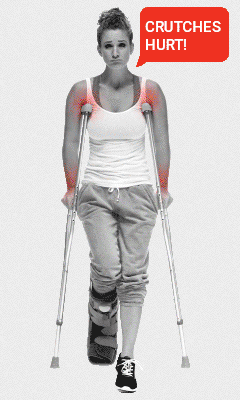Lower Leg Injury Resource Center
Sprained Ankle
Diagnosis, Treatment and Recovery
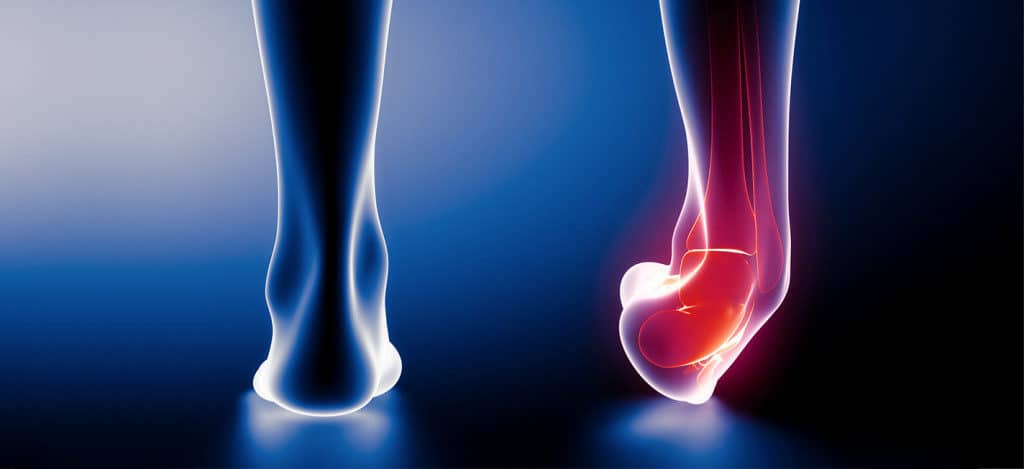
Ankle sprains are one of the most common ankle injuries, but they can also be complex and very painful. Even a small sprain can cause increased tightness of the calf, decreased coordination, and, in some cases, ankle arthritis—all of which increase the chance of re-injury. An ankle sprain may not seem like a big deal at first, but it’s an injury that should be taken seriously.
I
WHAT IS A SPRAINED ANKLE?
An ankle sprain occurs when the ankle twists unnaturally and damages the joint’s ligaments, causing pain and swelling.
There are two main ligaments in the ankle, the Calcaneofibular ligament and the Anterior talofibular ligament. These two ligaments hold the ankle bones in position, and their job is to protect the ankle from twisting or turning, and to protect the foot from rolling [1].
A ligament is like a rubber band, able to stretch within its limits and return to its original shape. Like a rubber band, if it’s stretched too much, a sprain or strain will occur. A severe sprain can cause actual tearing of the ligament’s elastic fibers, similar to what happens when a rubber band is stretched beyond its limit.
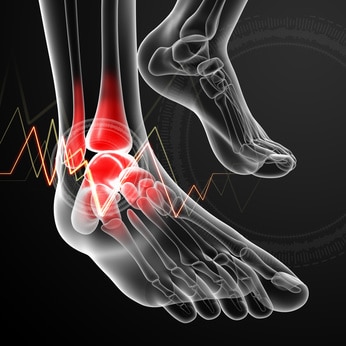
I
COMMON CAUSES OF ANKLE SPRAINS
Sprained ankles can happen almost anywhere and are surprisingly common. The biomechanical movements that cause such injuries involve rotation or rolling of your ankle in either direction and can happen while doing any of the following activities:
- Stepping off a curb,
- Walking or running,
- Tripping over your dog, cat, child or furniture,
- Landing with an angled foot after jumping,
- Rolling or twisting to the side of a high-heeled shoe [2].
I
HOW DO I KNOW IF MY ANKLE IS SPRAINED?
Ankle sprains tend to create pain, swelling, bruising and tenderness around the ankle joint, as well as making it difficult or impossible to bear weight on the affected leg. Symptoms can be similar or identical to a broken ankle, so it’s important to see a doctor for a proper diagnosis.
Specific symptoms of a sprained ankle may include:
- Pain at one or both sides of the ankle,
- Swelling, often extensive, throughout the ankle joint,
- Tenderness on the skin around your ankle,
- An inability to bear weight or move your ankle,
- Redness or bruising of the skin around the ankle,
- A sound like a pop or snap may occur during an extreme sprain.
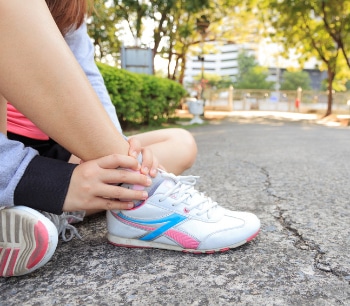
I
TYPES & SEVERITY OF SPRAINED ANKLES
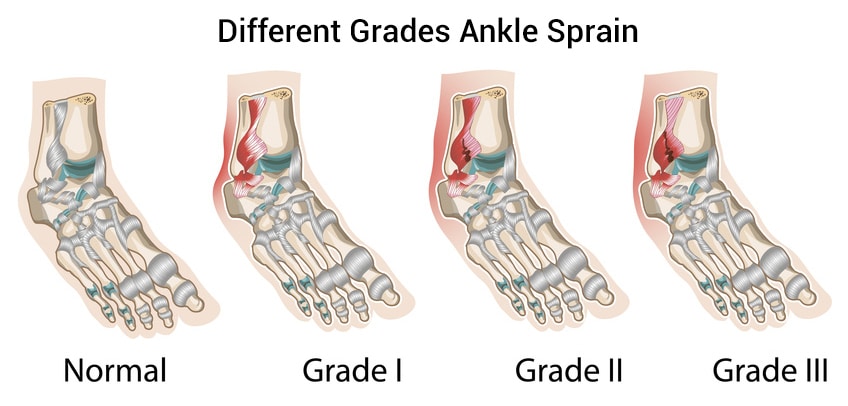
Ankle sprains come in two distinct types, and medical professionals group them into three levels or grades [4]. Types are related to the injury’s location and the ligaments affected. Grades relate to the injury’s severity.
Low or Common Ankle Sprains
When ligaments on the outside of the ankle, or the anterior talofibular ligament become injured, it is considered a common ankle sprain. This ligament stabilizes the ankle, and rolling the ankle is often the cause when it’s injured. This common ankle sprain usually requires a relatively short rehabilitation time.
High Ankle Sprains
The high ankle ligaments are called the syndesmosis, and a high ankle sprain is when the syndesmosis is torn or damaged, usually from a sudden twisting, turning or cutting motion when a person is running or jumping. The syndesmosis ligaments are located above the ankle and connect the tibia to the fibula.
This is a common injury for athletes playing high-impact running sports like football, rugby, soccer or basketball, but it is far less common than a common ankle sprain.
Grade 1 Sprain
A Grade 1 sprain involves light stretching and some damage to the fibers of a ligament. There is minimal tenderness and swelling, and an ongoing ability to move the joint. Walking may be painful.
Grade 2 Sprain
A Grade 2 ankle sprain involves partial tearing of the ligament or ligaments involved. A person with a Grade 2 sprain will experience abnormal looseness and movement when the joint is moved. A Grade 2 ankle sprain produces moderate swelling and tenderness, decreased range of motion and possible instability. Walking with a Grade 2 ankle sprain is painful, but not impossible.
Grade 3 Sprain
A Grade 3 ankle sprain produces a complete tear of the ligament. If the ankle joint is pulled or pushed, severe looseness and movement of the joint become apparent. A Grade 3 sprain produces significant swelling and pain and significant instability. Walking on a Grade 3 ankle sprain is impossible.
I
SPRAINED ANKLE TREATMENT
Treatment varies depending on the type and grade of the sprain. If you suspect an ankle sprain, see a doctor as soon as possible to make sure you don’t have a broken ankle because symptoms are often similar.
There are some simple steps you can take at home to treat the ankle to see if it improves [5]. Notably, you can control swelling and pain using medication and the RICE method, which employs rest, ice, compression and elevation.
Inflammation Control and Pain Relief Using Medication
A medication such as Ibuprofen will help with the initial discomfort of your ankle sprain. Many over-the-counter medications are used not only for pain relief, but also to reduce inflammation. Common over-the-counter pain relievers such as nonsteroidal anti-inflammatory drugs and aspirin will reduce inflammation. Your doctor may recommend one of the following:
- Ibuprofen (Advil and Motrin)
- Naproxen (Aleve)
- Tylenol (Acetaminophen)
- Generic Aspirin
- Topical Creams: (Many of the analgesics active ingredients can be found in creams. If your ankle is not in a cast, direct placement of a topical cream on the injury can offer immediate pain relief.)
RICE
The acronym, RICE, stands for Rest, Ice, Compression and Elevation. RICE is a time-honored way of healing a number of lower leg and foot injuries, including a sprained ankle [6].
Rest
Sometimes the best way to rest your leg is to stop standing and walking on it. Your doctor will tell you how long you need to stay off your ankle, and it will depend on the type and severity of your sprained ankle. The time can range, however, from several weeks to several months. Sometimes even just a few days of keeping weight off your ankle are all that’s needed to start feeling better, and there are several mobility devices to choose from to help you stay off your injured foot while allowing it to heal.

Ice
Placing ice on the most painful area of the ankle while you rest will also be helpful. It can be done throughout the day to help with swelling and pain relief. You can ice for up to 20 minutes, up to four times a day, but do not place the ice directly on your skin. Use a thin cloth between the ice and your skin to protect from ice burn. If your skin becomes red or numb, remove the ice pack, and ice for shorter periods of time.
Compression
A compression wrap can help control swelling while immobilizing and supporting your injured ankle. Applying a compression wrap, elastic bandage or Ace bandage is fairly easy and can be done at home. For a quick reference on the correct method, here’s a video: “How to Wrap an Ankle With an Ace Bandage.” For additional support you can wear a protective brace or splint. Both are relatively inexpensive and can be found at most drugstores.
Elevation
Whenever possible, elevate your sprained ankle to help prevent or limit swelling. Elevating the injured ankle above your heart keeps fluid and blood from pooling in the ankle due to gravity. The best way to elevate your sprained ankle in bed is to place several pillows under your leg, one under your knee and one under the ankle. You can also elevate your ankle in a recliner, but place several pillows under it so it’s higher than your heart. Keep your ankle elevated for 48 hours and don’t walk on it.
If your sprain improves with the RICE treatment, seeing a doctor may not be necessary. However, if you experience any of the following symptoms you should see a doctor:
- The pain is difficult to bear,
- The swelling doesn’t go down with the RICE treatment,
- You experience significant instability in the joint.
Be cautious, because self-diagnosed ankle sprains can often hide a broken bone. If your ankle isn’t improving, see a doctor who may order X-rays to check for broken bones in the foot or ankle. The injured ligament may feel tender, and the doctor may need to move your ankle into a variety of positions to determine which ligament has been hurt or torn.
I
HOW LONG SHOULD IT TAKE FOR AN ANKLE SPRAIN TO HEAL?
The healing process for a sprained ankle takes four to six weeks. Surgery is rarely required, which is great news!
Even a complete ligament tear can heal without surgery if it is immobilized appropriately and treated properly. Rehabilitation is also an important part of healing from a sprained ankle. Ankle stretches and ankle-strengthening exercises can significantly improve your success and help you get back to normal activities [7]. You will go through three phases of healing as you recover from a sprained ankle:
- First: Resting and protecting the ankle while reducing swelling using the RICE protocol for one week.
- Second: Restoring range of motion, strength and flexibility for one to two weeks.
- Third: Gradually returning to activities that do not require turning or twisting of the ankle and performing stretching exercises.
Once the ankle is pain free you can start doing strengthening exercises followed by getting back into activities like tennis, basketball or football. The recovery phases can collectively take weeks to months depending on the severity of your sprain.
People who sprain their ankles have increased risk of incurring the injury again, so make sure you fully rehabilitate your sprained ankle before resuming regular activities. The final phase of recovery from an ankle sprain is working on balance. Having good balance and proprioception will help keep you from suffering future ankle sprains.
I
WALKING ON A SPRAINED ANKLE
Depending on the grade of your injury, you may be given a removable plastic device such as a walking boot or air splint to wear while you recover. To help you recover as quickly and safely as possible, consider crutches, knee scooters, or the iWALK hands-free crutch to help with mobility while you rest the injury.
Traditional Crutches
While crutches are inexpensive and effective, they can cause pain in your hands, arms, wrists and forearms. When using crutches to walking or stand you will not have use of your hands and arms, making everyday tasks like carrying something from one room to the other impossible. Furthermore, crutches will help you keep your leg partially elevated, which is one of the benefits of knee scooters and the iWALK hands-free crutch.
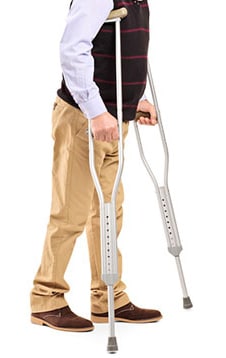
Knee Scooters or Knee Walkers
Knee scooters are becoming increasingly popular due to the general dislike of crutches. With knee scooters, you kneel on a platform and roll by propelling yourself with your good foot. A knee scooter is efficient for covering distances but doesn’t work well on uneven terrain, grades or tight places. Knee scooters are heavy and bulky as well. They are restrictive when performing daily activities, and you cannot use them on stairs. You will also need both hands to operate a knee scooter.
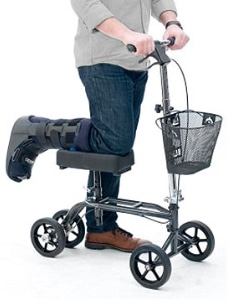
iWALK Hands-Free Crutch
The iWALK hands-free crutch is a pain-free and hands-free crutch alternative that combines the best of knee scooters and conventional sprained ankle crutches for sprained ankle recovery. Like a knee scooter, you kneel on a platform, so your weight is supported by your leg, not your hands and arms.
Unlike a knee scooter, though, the iWALK crutch is lightweight, inexpensive and 100 percent hands free. It also makes it possible to walk normally by using the crutch as an extension of your leg, so you can continue with your daily routine. It’s fast and easy to learn and use, and allows you to navigate stairs and tight spaces like a kitchen or bathroom with ease. You can even use it while showering.
Recent clinical research showed that 86 percent of non-weight bearing patients preferred the hands-free crutch over other mobility devices. Moreover, additional studies show the iWALK boosts blood-flow and reduces muscle atrophy, which in turn accelerates healing.
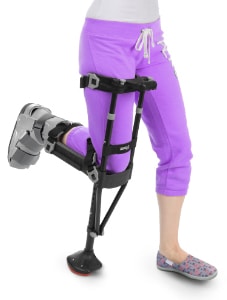
I
ANKLE SPRAIN PREVENTION TIPS
People who sprain their ankles are unfortunately more prone to re-injury, but there are ways to prevent future ankle sprains [8]. We can’t always predict or prevent injuries from happening, but we can take measures to ensure we have a lower risk as we participate in physical activities.
Warm Up
Lightly stretch your muscles, but don’t force a stretch by bouncing. Perform the movement until you can tension in the tendons and muscles and hold for 15 to 20 seconds. Jog in place for a few minutes to warm up before starting any physical activity.
Conditioning
Conditioning your muscles for the activities you’re participating in is important. The amount of time spent on the activity should be increased gradually to build muscle strength and mobility. Cross training can also help.
Choose athletic shoes specifically for your foot type
This is a very important part of preventing foot injuries, even for people who don’t participate in sports [9]. People with low arches should choose shoes that provide support in both the front of the shoe and under the arch. The back of the shoe should be very stable. People with high arches should choose shoes with more cushion and softer platforms. When possible, use sport-specific shoes.
Replace athletic shoes regularly
Most people should replace their shoes every six months. Athletes, however, should replace their shoes far more often. So when the heel of your shoe feels worn and soft, or the tread is thin, that is a reminder to get new footwear.
The information above is intended for informational purposes only and is not intended to prevent, treat, or diagnose any illness or disease. We aim to provide the highest quality information, so if you have any questions on the information above, we welcome your feedback!
I
RESOURCES
- Golanó, P., Vega, J., de Leeuw, P. A., Malagelada, F., Manzanares, M. C., Götzens, V., & van Dijk, C. N. (2010). Anatomy of the ankle ligaments: a pictorial essay. Knee surgery, sports traumatology, arthroscopy: official journal of the ESSKA, 18(5), 557–569. https://doi.org/10.1007/s00167-010-1100-x
- Sprained Ankle. Ortho Info. Accessed 2 October 2021. https://orthoinfo.aaos.org/en/diseases–conditions/sprained-ankle/
- John Davine, MD. Varying Degrees of Ankle Sprains. Rush Accessed 2 October 2021. https://www.rushcopley.com/health/physician-articles/varying-degrees-of-ankle-sprains/
- Mayo Clinic Staff. Sprained Ankle. Mayo Clinic. Accessed 2 October, 2021. https://www.mayoclinic.org/diseases-conditions/sprained-ankle/diagnosis-treatment/drc-20353231
- Healthwise Staff. Rest, Ice, Compression, Elevation (RICE). University of Michigan. 16 November 2021. https://www.uofmhealth.org/health-library/te7604
- Preventing Ankle Sprains. Williams College. Accessed 2 October, 2021. https://health.williams.edu/medical-diagnoses/general-health-concerns/preventing-ankle-sprains/
- What’s the Best Way to Support Your Ankles During Exercise? Healthessentials. Accessed 25 May 2021. https://health.clevelandclinic.org/can-high-top-shoes-help-avoid-ankle-sprains/

